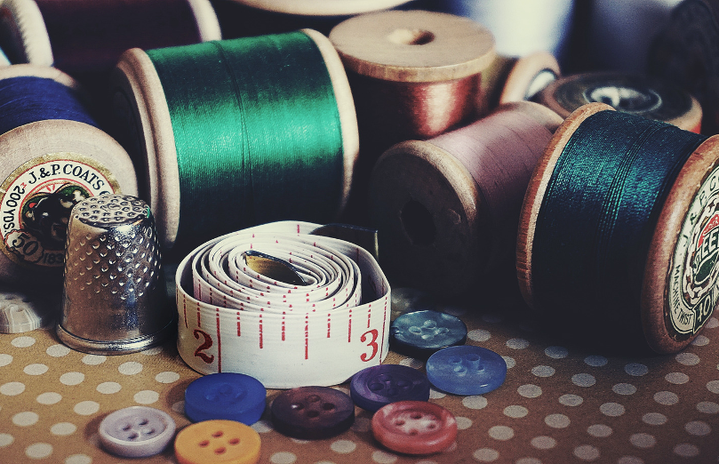As a knitter, I love the feel of the yarn slipping through my fingers where I’d spend as much time petting the fabric as I do knitting it. Lost in the rhythm of those repetitive stitches and knots, the satisfaction of finishing something and wearing it makes the practice a creative outlet with therapeutic benefits. If that’s not convincing enough, science says an hour of knitting/crocheting burns 100-150 calories an hour, whilst binge-watching your favorite show. Productive? Check. Serotonin? Check. Workout? Check.
Quick Tip: With gift cards and t-shirts out of the picture in the 21st-century gift-giving trope, a warm and cuddly scarf or blanket would earn you some brownie points with your friends, and additionally, donating them will get you a good track record of karma maybe.
Also, exclusively for the cynics reading: what is the appeal of knitting as a hobby considering there is a steep learning curve involved to be proficient at it and even when you achieve that level of skill, it persists to be very a tedious activity to do? Why is it that people won’t just buy the textile in its done and dusted way when the efficiency of skill is not in the picture anymore? The very essence of this capitalist mindset has cast an impression of how you should be automatically good at every hobby you have.
How Gender Roles and History made up the Perfect Dysfunctional Purl Stitch?
It wasn’t until the mid to late 19th century that producing knitwear became associated with domesticity. Before that, both men and women knitted professionally for centuries. Author and historian Penelope Hemingway quote, “For the middle classes, it became a parlor hobby, consigned to the part of women’s lives lived in the spaces between men’s more public-facing lives. This ‘feminizing’ led to knitting being perceived as an ‘idle’ waste of time; a feminine pursuit to be followed safely from within the cage of domesticity.” In a time when the textile industry was booming, women resorted to this activity as an ingenious way to assert authority and access their rights.
While baking and gardening have mostly gotten out of the spiral of being associated with ‘womens’ work’, this part of the textile paradigm still remains laden with stereotypes in public imagination. To address its silhouette on the older generations, knitting (and crocheting) remained a useful outlet for the elders to stay economically, physically and mentally active in an era where state welfare and pensions didn’t exist. History flowed, times changed, but this tag of it being a “domestic” craft continues to conjure images of an elderly white woman, sitting in a rocking chair or in a circle of her peers.
Constantly falling in and out of favor, its internalized imprint on housewives became more pronounced after the World Wars and Great Depression when women were encouraged to knit for the war effort or turn to knit and mending out of necessity; knitting still maintains connotations with the familial structures, gender roles, and tastes of women who embraced it long ago.
Small Business Industry – The Tapestry Needle of a Knitted Sweater
Like most things in the world of high fashion, handmade woolen textiles have come and gone quite frequently over yarns and yarns of time. The 20th century, however, is a catalyst for knitting to come into proper fashion thanks to a new generation of designers, who are transforming the ‘old-fashioned’ practice into a high-fashion art form. For the most part of it, knitwear was used in clothing that was relatively conventional and “basic” as per the current fad, but towards the end of it, designers like Vivienne Westwood and Alexander McQueen began using knits in unusual ways to create edgier garments.
A “niche” pursuit as it is, the current generation is deeply influenced and fascinated by it, and with the increasing need to be personally and financially rewarding, this section of the industry offers to not only provide us with these exact requirements but also eradicate the stigma talked about above that has been going on for centuries. One of the biggest and most surprising accomplishments, though, is watching people knitting their sweaters and realizing the real value of handmade items. They now understand and appreciate the time and effort that goes into them. This shift in consumer perception and individual gratification has tipped the small business textile industries into transforming the insidious biases of ageism and sexism into something sustainable and creative.
Now that internet forums, blogs, and social media platforms have been a vital resource in introducing younger generations to the craft and to keeping the tradition alive, a crocheter or a knitter realizes how damaging the fast fashion industry is and turns to make their clothes.
What everybody failed to read into was the underlying thought, chemistry, and mechanization to turn that loose yarn into neat little stitches and further, into a garment. Piece by piece, purl by purl, when the first inch of your fabric is sitting perfectly on your needle, you, my friend, are a bonafide knitter even when the world perceives it to be a soft skill.


